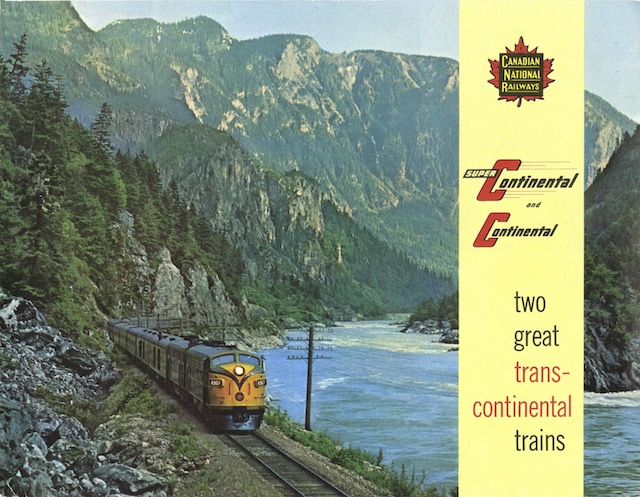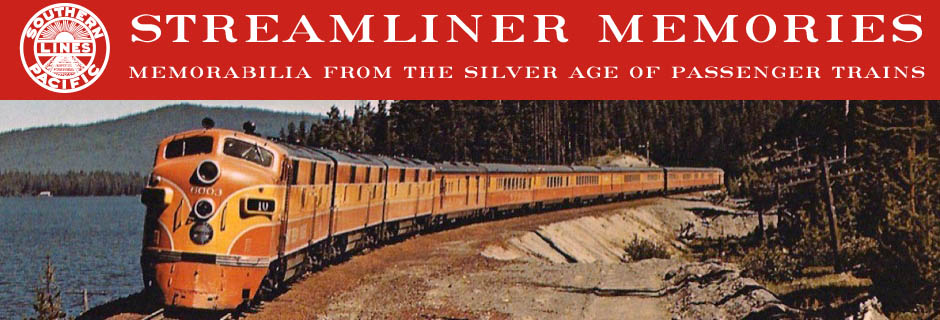This brochure advertises Canadian National’s “two great transcontinental trains,” which were in reality one pretty good train and one not-so-great train. In addition to coaches, the Super Continental had both “standard” sleepers (roomettes, double bedrooms, and sections) and “tourist” sleepers (roomettes and sections) that were somehow less expensive than standard. Both kinds of sleepers had their own lounge car.
 Click image to download a 3.0-MB PDF of this brochure.
Click image to download a 3.0-MB PDF of this brochure.
The Super Continental also had a complete array of dining facilities. A full diner went from Toronto to Vancouver while a went dinette from Montreal to Vancouver. The two trains joined in Capreol, Ontario. To accommodate budgets, a parlor-grill car went from Montreal to Capreol and a coffee shop-lounge car from Toronto to Capreol. In short, the train had several levels of accommodations and plenty of dining and lounge facilities for the entire journey. All it was missing was the dome cars featured on its competitor, the Canadian.
The Continental was a much more plebeian affair. It had coaches, of course, but according to my October, 1960 timetable, it had sleeping cars only from Vancouver to Kamloops, Edmonton to Saskatoon, and Montreal to Englehart (wherever that is). In other words, sleeping spaces were available for the nighttime portions of the trip but passengers would have to vacate them for the daytime portions, often quite early in the morning.
In addition, there were no food facilities except a grill car (pictured in this brochure), and that only went from Montreal to Ottawa on a daily basis and from Ottawa to Montreal on Sundays only. The other days the car was used on train #48, which operated nonstop from Ottawa to Montreal daily except Sunday. For the rest of the trip (which was nearly all of the trip, and all of it for Toronto passengers), passengers would have to bring their own food. Admittedly, the October 1960 timetable would have been for off-season travel; perhaps more dining options were available during the summer. But it doesn’t sound like an appealing trip.
Interestingly, the eastbound Continental arrived in Ottawa at 7:00 am and departed at 7:50. Train #48 left at 7:45 am. Hungry transcontinental passengers might have done well to hop off the Continental and get on train #48 so they could enjoy breakfast on the way to Montreal. Train #48 would also have gotten them to Montreal 95 minutes sooner than the Continental.
Some secondary trains were timed to serve cities in daylight hours that were reached by the primary train only late at night. However, Canada is spread out enough that no major cities were served by the Super Continental late at night. The largest was probably Kamloops, whose population was only about 10,000 people in 1960. The eastbound Continental arrived in Kamloops at 4:45 am, so it wasn’t much of an improvement on the Super Continental, which arrived at 2:15 am.
Far from being a great transcontinental train, the Continental was a modest train aimed mainly at short-distance passengers. Beyond being clearly unequipped to serve long-distance passengers, it took 12 hours more eastbound and 16 hours more westbound than the Super Continental. Anyone enticed by this brochure to take the Continental on a transcontinental trip would have been severely disappointed.

CNR never had the same quality onboard product either. Both lines made huge mistakes with ordering new equipment in the 1950’s with open sections as demand for them was plummeting.
So the rough equivalents in American railroading would have been:
Canadian = ATSF Chief
Super Continental = SP Golden State
Continental = SP Sunset circa 1966